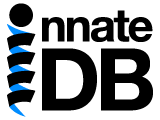|
InnateDB Protein
|
IDBP-233627.6
|
|
Last Modified
|
2014-10-13 [Report errors or provide feedback]
|
|
Gene Symbol
|
CRYBB2
|
|
Protein Name
|
crystallin, beta B2
|
|
Synonyms
|
CCA2; CRYB2; CRYB2A; CTRCT3; D22S665;
|
|
Species
|
Homo sapiens
|
|
Ensembl Protein
|
ENSP00000381273
|
|
InnateDB Gene
|
IDBG-401988 (CRYBB2)
|
|
Protein Structure
|

|
| Function |
Crystallins are the dominant structural components of the vertebrate eye lens.
|
| Subcellular Localization |
|
| Disease Associations |
Cataract 3, multiple types (CTRCT3) [MIM:601547]: An opacification of the crystalline lens of the eye that frequently results in visual impairment or blindness. Opacities vary in morphology, are often confined to a portion of the lens, and may be static or progressive. CTRCT3 includes congenital cerulean and sutural cataract with punctate and cerulean opacities, among others. Cerulean cataract is characterized by peripheral bluish and white opacifications organized in concentric layers with occasional central lesions arranged radially. The opacities are observed in the superficial layers of the fetal nucleus as well as the adult nucleus of the lens. Involvement is usually bilateral. Visual acuity is only mildly reduced in childhood. In adulthood, the opacifications may progress, making lens extraction necessary. Histologically the lesions are described as fusiform cavities between lens fibers which contain a deeply staining granular material. Although the lesions may take on various colors, a dull blue is the most common appearance and is responsible for the designation cerulean cataract. Sutural cataract with punctate and cerulean opacities is characterized by white opacification around the anterior and posterior Y sutures, and grayish and bluish, spindle shaped, oval punctate and cerulean opacities of various sizes arranged in lamellar form. The spots are more concentrated towards the peripheral layers and do not delineate the embryonal or fetal nucleus. Phenotypic variation with respect to the size and density of the sutural opacities as well as the number and position of punctate and cerulean spots is observed among affected subjects. {ECO:0000269PubMed:10634616, ECO:0000269PubMed:9158139}. Note=The disease is caused by mutations affecting the gene represented in this entry.
|
| Tissue Specificity |
|
| Comments |
|
|
Number of Interactions
|
This gene and/or its encoded proteins are associated with 16 experimentally validated interaction(s) in this database.
| Experimentally validated |
| Total |
16
[view]
|
| Protein-Protein |
16
[view]
|
| Protein-DNA |
0
|
| Protein-RNA |
0
|
| DNA-DNA |
0
|
| RNA-RNA |
0
|
| DNA-RNA |
0
|
|
|
|
Molecular Function |
|
| Biological Process |
|
| Cellular Component |
|
| PDB ID |
|
| InterPro |
IPR001064
Beta/gamma crystallin
IPR011024
Gamma-crystallin-related
|
| PFAM |
PF00030
|
| PRINTS |
PR01367
|
| PIRSF |
|
| SMART |
SM00247
|
| TIGRFAMs |
|
| Modification |
|
| SwissProt |
P43320
|
| PhosphoSite |
PhosphoSite-P43320
|
| TrEMBL |
R4UMM2
|
| UniProt Splice Variant |
|
| Entrez Gene |
1415
|
| UniGene |
Hs.373074
|
| RefSeq |
NP_000487
|
| HUGO |
HGNC:2398
|
| OMIM |
123620
|
| CCDS |
CCDS13831
|
| HPRD |
00430
|
| IMGT |
|
| EMBL |
BC069535
CR456426
KC683809
L10035
U72400
U72401
U72402
U72403
U72404
Z99916
|
| GenPept |
AAA16864
AAB39700
AAH69535
AGM34047
CAB17043
CAG30312
|
|
|
|

